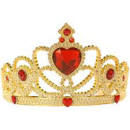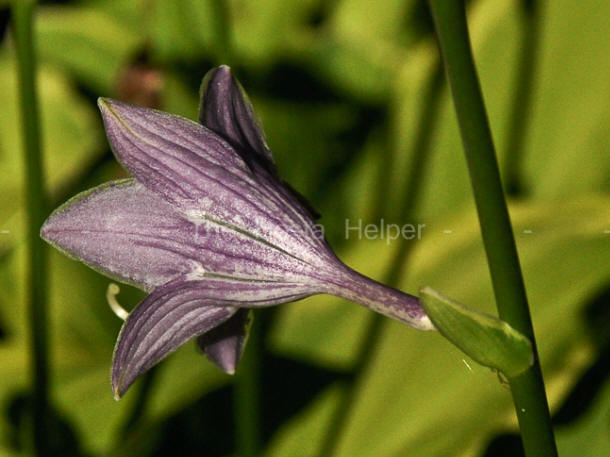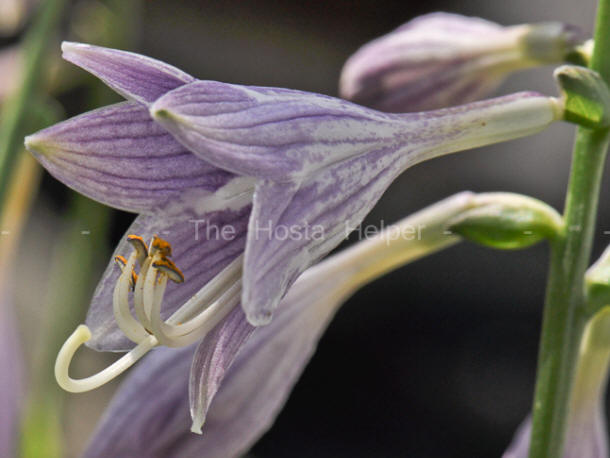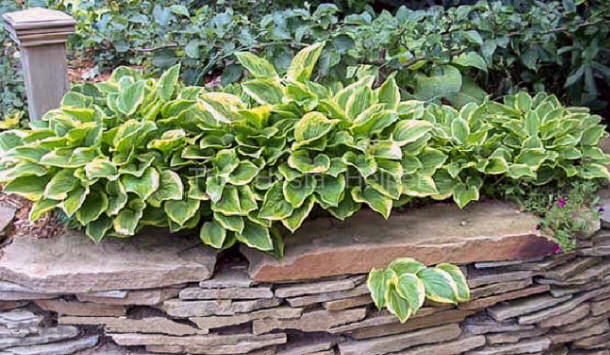|
 This classic hosta first appeared
on the market in the 1970's. It is a sport of
H. nakaiana
and was registered by
Robert Savory
of Savory's Gardens in Minnesota in 1977. This classic hosta first appeared
on the market in the 1970's. It is a sport of
H. nakaiana
and was registered by
Robert Savory
of Savory's Gardens in Minnesota in 1977.
 It is considered
a medium size (16 inches high by 39 inches wide) mound and is a rapid grower and multiplier that works
great as an edger plant or groundcover. The leaves are of average substance and
are slightly wavy and corrugated. It has pale purple flowers that are
funnel shaped from mid-July to August followed by viable seeds. It is considered
a medium size (16 inches high by 39 inches wide) mound and is a rapid grower and multiplier that works
great as an edger plant or groundcover. The leaves are of average substance and
are slightly wavy and corrugated. It has pale purple flowers that are
funnel shaped from mid-July to August followed by viable seeds.

According to
The Hostapedia by Mark Zilis (2009), "When I began working with hostas in the late 1970s,
'Golden Tiara' ranked as a "hot new introduction", being the
first small-size hosta with gold-margined leaves. Everyone had
to have it. the going price was about $50 per plant, so when I
was able to purchase one for $40 at an auction, I felt
fortunate. Since that time, 'Golden Tiara' has been widely
propagated and is now a common sight in shade gardens."
The New Encyclopedia of Hostas by
Diana
Grenfell (2009) states: "Leaves are variable in shape, the outer ones being
oval, the inner ones sometimes almost round. Flowers run a deeper
purple when exposed to sunlight. Some rebloom is possible if spent
scapes are removed. Among the most important hostas ever introduced.
Lovely in a container."
This cultivar has been awarded the Royal Horticultural Society's
Award of Garden Merit in the
UK. Winner
of the 1994 Alex J. Summers Distinguished Merit Hosta Award.
H. 'Golden Tiara' was the first
of a large series of plants called the
Tiara Group.



An article by
Bob Solberg in
The
Hosta Journal (1994 Vol. 25 No. 2) states that "Bob
Savory's 'Lemon Lime'
and 'Golden Tiara', both registered in 1977, are hosta
breakthroughs, but not because H. nakaina is their
parent. (It is also the parent of many of
Eunice
Fisher's small-to-medium sized hybrids.) Rather it is
because of their bright spring color and extremely fast rate of
increase. 'Golden Tiara' is often listed as a H. nakaiana
hybrid, as 'Lemon Lime' is, but it is really an induced mutation
of a H. nakaiana seedling.

In an effort to create hostas that rapidly increased, seven
hundred fifty H. nakaiana seedlings were treated with a
mixture of hormones and vitamins. The sport of one of these
seedlings was named 'Golden Tiara'. No hostas compare with these
two of Savory's for rate of increase or repeat blooming
throughout the season."
An article by Robert Savory in
The
Hosta Journal (1985 Vol. 16) states that, "H. 'Golden
Tiara' appeared as a result of our propagation experiments using
H. nakaiana
seedlings in the 1970's. We wanted to increase the number of shoots of seedling
plants of H. nakaiana so we could hasten our crown-cutting propagation to meet
the heavy demand for them. We treated 750 H. nakaiana seedlings with a mixture
of hormones and vitamins in order to "break" more dormant eyes and to possibly
stimulate mutations in these highly desirable small-leaved hostas...H.
'Golden
Tiara' was one of several induced sports that appeared in this group." An article about leaf color change by Warren I. Pollock in
The
Hosta Journal (1991 Vol. 22 No. 1) cites an extract from
The Genus Hosta by W. George Schmid on seasonal changes in hosta leaf
colors:
| |
|
| Viridescence |
Emerging with yellow or whitish
color that ultimately become increasingly green. An example is
H. 'Fortunei Albopicta' whose green-bordered leaves have a
beautiful, bright yellow-colored center in the spring that turns to
green by midseason. |
| Partial Viridescence |
Emerging with yellow or whitish
color that turns to chartreuse (yellowish green), sometimes a dark
chartreuse. One example is H. 'Kabitan'; two others are 'Golden
Scepter'...and the center leaf coloring of 'Golden
Tiara'. |
| Lutescence |
Emerging green or chartreuse and
turning yellow or whitish yellow. The coloring of leaf centers
of 'Gold Standard'. ..is an example. |
| Albescence |
Yellow, yellowish green or green
areas that turn to near white. Examples are the center leaf
coloring of 'Janet'...and the margins of 'Antioch'...and H. ventricosa 'Aureomarginata'. |
An article in
The Hosta Journal (1995 Vol. 26 No. 1) citing Vol. 1, #2, Fall 1993,
Great Lakes Region Newsletter included a list of Classic Hostas from
Peter Ruh:

An article by Warren I. Pollock in
The
Hosta Journal (2000 Vol. 31 No. 1) states that, "H.
'Diamond Tiara' (Zilis - 85). This is my favorite member of the Tiara Group
because its green leaves having a white border don't lose their pizzazz and
become blah as do its siblings, such as H. 'Golden Tiara' (Savory - 77) and the
gold leaved H. 'Golden
Scepter' (Savory - 83) in my garden come summertime."







|



